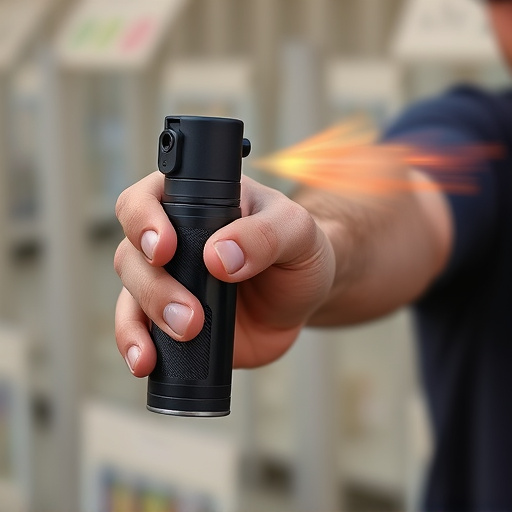Non-lethal deterrent devices like pepper spray require proper training, understanding of local laws, and effective aftercare for safe and responsible usage. In case of exposure, immediate first aid includes moving to a safe area, removing contaminated clothing, rinsing eyes with clean water for 15 minutes or more, and gently washing affected skin areas. Seeking medical attention is advised if symptoms persist or worsen. Regular maintenance and knowledge of first aid procedures are crucial for minimizing discomfort and health risks associated with pepper spray use.
“In today’s world, personal security is a top priority. Non-lethal deterrent devices, like pepper spray, offer a powerful yet safe option for self-defense. This comprehensive guide explores the ins and outs of these life-saving tools, focusing on pepper spray as the most common choice. We’ll delve into its uses, effects, and importance, while also providing crucial insights on aftercare and first aid following exposure. Additionally, we’ll navigate the legal considerations and best practices for carrying a personal security device, empowering you with knowledge to protect yourself effectively.”
- Understanding Non-Lethal Deterrent Devices: A Comprehensive Overview
- Pepper Spray: The Most Common Non-Lethal Option – Its Uses and Effects
- Aftercare and First Aid Following Pepper Spray Exposure: What You Need to Know
- Legal Considerations and Best Practices for Carrying a Personal Security Device
Understanding Non-Lethal Deterrent Devices: A Comprehensive Overview
Non-lethal deterrent devices, designed to protect individuals and deter potential threats without causing permanent harm, have gained significant attention in recent years. These innovative tools offer a range of options, from personal alarms to stun guns and pepper spray, each with unique features and applications. Pepper spray, for instance, is a popular choice known for its effectiveness in neutralizing attackers temporarily.
Understanding the proper use and aftercare of such devices is crucial. After an incident involving pepper spray, immediate first aid becomes essential. This includes ensuring the victim’s safety, removing contaminated clothing, and providing access to clean water or eye washes. Proper training and education on these non-lethal deterrent devices empower individuals to protect themselves while promoting responsible usage and minimizing potential side effects.
Pepper Spray: The Most Common Non-Lethal Option – Its Uses and Effects
Pepper spray is one of the most widely recognized and commonly used non-lethal deterrent devices for personal security. Its primary function is to incapacitate an assailant temporarily, allowing the user to escape or seek help. This type of spray is a popular choice due to its relatively low risk of causing permanent harm compared to lethal force options.
When deployed, pepper spray irritates the eyes, nose, and respiratory system, leading to temporary blindness, coughing, and difficulty breathing. Aftercare for those affected by pepper spray involves immediate washing of the eyes and face with water to remove any residual spray. First aid measures should be taken, including ensuring the victim is in a safe location and monitoring their condition until the effects subside. Proper aftercare is essential to minimize discomfort and potential long-term health issues associated with exposure to pepper spray.
Aftercare and First Aid Following Pepper Spray Exposure: What You Need to Know
After using a pepper spray personal security device, proper aftercare and first aid are essential to mitigate discomfort and potential health risks. If exposed to pepper spray, quickly move to a safe, well-ventilated area to prevent further inhalation. Remove any contaminated clothing or accessories, rinse eyes thoroughly with clean water for at least 15 minutes, and gently wash the affected skin areas with mild soap and warm water.
It’s crucial to seek medical attention if symptoms persist or worsen, especially difficulty breathing, chest pain, nausea, or dizziness. Pepper spray can cause irritation, redness, and itching, but with prompt first aid and proper aftercare, most individuals will recover fully. Keep a well-stocked first aid kit handy, including eye wash solutions, antihistamines, and any prescribed medications to address potential pepper spray exposure symptoms effectively.
Legal Considerations and Best Practices for Carrying a Personal Security Device
When considering a personal security device like pepper spray, it’s crucial to understand the legal implications and best practices for carrying such a tool. Each jurisdiction has specific laws regarding the use, storage, and transportation of pepper spray, among other non-lethal deterrents. Before purchasing or carrying any self-defense device, individuals should research and comply with local regulations, which may include age restrictions, registration requirements, and permitted uses.
Best practices involve keeping the device easily accessible yet secure, ensuring proper training in its use, and understanding the aftercare process for Pepper Spray First Aid. Regular maintenance of the device is essential, including checking expiration dates on the spray canisters and learning basic first aid techniques in case of accidental exposure or misuse. Additionally, users should stay informed about their rights and responsibilities, fostering a culture of responsible self-defense that prioritizes safety and de-escalation over aggression.
In light of the growing importance of personal security, understanding non-lethal deterrent devices like pepper spray is essential. This article has provided a comprehensive overview of these tools, highlighting their effectiveness, particularly pepper spray, and its diverse uses. It’s crucial to remember that while these devices offer protection, proper aftercare and first aid following exposure are vital. Knowing how to manage any adverse effects ensures users remain safe. Additionally, legal considerations play a significant role in carrying personal security devices, emphasizing the need for responsible use and awareness of local regulations.
